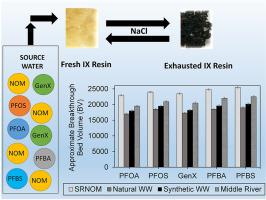Water Research ( IF 11.4 ) Pub Date : 2020-06-26 , DOI: 10.1016/j.watres.2020.116098 Fuhar Dixit 1 , Benoit Barbeau 2 , Shadan Ghavam Mostafavi 1 , Madjid Mohseni 1

|
We present the first study investigating optimized regeneration strategies for anionic ion exchange (IX) resins during the removal of persistent per- and poly-fluoroalkyl substances (PFAS, including GenX) from surface and treated wastewater effluents. IX regeneration studies are of critical importance from environmental perspectives. Specifically, the knowledge is essential for water utilities who presently operate IX (for PFAS removal) in a single use-and-dispose mode. In this study, legacy PFAS such as PFOA/PFOS were tested along with other harmful short-chained PFAS (PFBA/PFBS) and other toxic perfluorinated substitutes (GenX). Studies were performed on synthetic water (spiked with Suwannee River Natural Organic Matter (SRNOM), Fulvic Acid (SRFA) and Humic Acid (SRHA)), surface water, and wastewater effluents, and the regeneration was performed in batch stirred reactors. The resin service life with and without regeneration was investigated in the presence of background organic matter. In ultra-pure waters, all PFAS (C0 ∼10 μg/L, concentrations similar to that of natural waters) were effectively removed for >100,000 Bed Volume (BV) of operation. This was reduced to ∼23,500 BV in the presence of SRNOM (C0 = 5 mg C/L), 20,500 BV in SRFA and 8500 BV in SRHA, after which the saturated resins required regeneration. More importantly, all resin breakthrough (PFAS> 70 ng/L) corresponded to > 90% resin site saturation (in meqs), an essential information for optimizing IX loading. The competitive dissolved organic matter (DOM) fractions were estimated to be approximately 5–9% of the initial DOC, as estimated by the IAST-EBC model. Finally, it was identified that IX regeneration efficiency improved with increasing brine contact time but effectiveness plateaued for brine concentrations above 10% (W/V). Nonetheless, a regeneration with 10% NaCl solution with a contact time of 2 h was found to be optimal for IX operations in synthetic and natural waters. Therefore, this study provides key knowledge essential for the scientific community and the water industry on optimizing IX operational parameters for DOM and PFAS removal and would be highly valuable for systems which presently operate IX in a use-and-dispose mode.
中文翻译:

去除传统的PFAS和其他含氟端粒:在富含DOM的水中优化的再生策略。
我们目前进行的第一项研究调查了从表面和处理后的废水中去除持久性全氟和多氟烷基物质(PFAS,包括GenX)过程中阴离子离子交换(IX)树脂的优化再生策略。从环境的角度来看,IX再生研究至关重要。具体来说,该知识对于目前以单一使用和处置方式运行IX(用于去除PFAS)的自来水公司至关重要。在这项研究中,对传统的PFAS(例如PFOA / PFOS)以及其他有害的短链PFAS(PFBA / PFBS)和其他有毒的全氟化代(GenX)进行了测试。研究人员对合成水(掺有Suwannee河天然有机物(SRNOM),黄腐酸(SRFA)和腐殖酸(SRHA)),地表水和废水进行了研究,并在间歇搅拌反应器中进行再生。在存在背景有机物的情况下,研究了有无再生的树脂使用寿命。在超纯净水中,所有PFAS(C0〜10微克/升,浓度类似于天然水域)为工作> 100,000床体积(BV)中有效地去除。在SRNOM存在的情况下(C 0 = 5 mg C / L),SRFA中的20,500 BV和SRHA中的8500 BV,之后需要再生饱和树脂。更重要的是,所有树脂突破(PFAS> 70 ng / L)对应> 90%的树脂位点饱和度(以meqs为单位),这是优化IX负载的必要信息。根据IAST-EBC模型估算,竞争性溶解有机物(DOM)比例约为初始DOC的5–9%。最后,可以确定的是,IX再生效率随着盐水接触时间的增加而提高,但是对于高于10%(W / V)的盐水浓度,有效性却保持稳定。尽管如此,对于在合成水和天然水中进行IX操作,发现10%NaCl溶液的再生时间为2小时的再生是最佳的。因此,











































 京公网安备 11010802027423号
京公网安备 11010802027423号